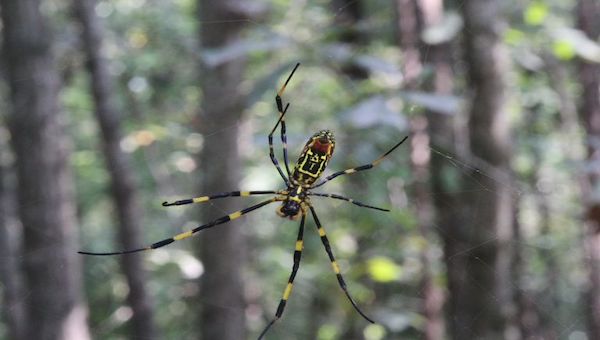
INVASIVE JORO SPIDERS SPINNING GOLDEN WEBS IN GEORGIA
BY: MARY JO DILONARDOSITE: TREEHUGGER
TRENDING
Activism
Belief
Big Pharma
Conspiracy
Cult
Culture
Economy
Education
Entertainment
Environment
Global
Government
Health
Hi Tech
Politics
Prophecy
Science
Social Climate
Universe
War
People throughout Georgia are creeping tentatively through yards and nature trails this fall in hopes of not walking headfirst into the web of a Joro spider.
Joro spiders ( Trichonephila clavata ) aren’t easy to miss. Mature females have yellow and dark blue stripes with red marks underneath. The females can be as large as almost 3 inches across with legs fully extended.
Their massive webs are also very impressive. They actually spin them in three layers: There’s the main basket-shaped orb surrounded by two additional webs in the front and back. When sunlight hits the strands , the web has a golden glow.
The webs are also incredibly durable and very elastic. (Ask any homeowner who has tried to remove one.)
“Textile engineers are fascinated by this material and there are several attempts to commercialize the silk through synthesis or gene insertion into Silk-Worm genome,” ecologist Byron “Bud” Freeman, director of the Georgia Museum of Natural History, tells Treehugger.
Joro spiders are found only throughout Georgia and in parts of South Carolina, Freeman says. Researchers believe the spiders arrived via shipping container sometime in the early 2010s.
In a 2015 paper in the journal PeerJ, Freeman and his colleagues wrote that there were many sightings of the spider around Braselton and Hoschton, Georgia.
"One property owner in Hoschton indicated that the spider had been present around her home for at the past 4 years. We are not necessarily suggesting that this area represents the probable arrival point of this Asian spider, but it could be argued that the industrial and business history of the region might demonstrate it to be a possibility. The town of Braselton is a thriving business location on the I-85 business corridor, located 64 km northeast of Atlanta. As such, its location on the I-85 corridor provides excellent transportation access. It is home to many warehousing and distribution facilities that transport containerized freight from overseas."
After the researchers published their paper, they received a Joro spider from the Port of Tacoma, Washington. The spider was on the side of a shipping container that read “China” on the side, Freeman says.
“This demonstrates that shipping can be a vehicle of transport,” says Freeman, who sequenced the DNA of the specimen and found that it shared some of the same characteristics with a sequence that was sourced from the shipping port in Taiwan.
Although no other Joros have been reported in Washington State—or anywhere outside of Georgia and South Carolina—it could happen.
“One of our students recently drove 300 miles to North Carolina and upon arriving noticed a Joro with web on the bumper of his vehicle,” Freeman says. “I think it is highly likely that this will be repeated when traveling from areas of high density—hitchhikers will occur and it the hitchhiker was a mature gravid female—then an opportunity to start a new population.”
Joro Spiders and the Ecosystem
:max_bytes(150000):strip_icc()/joro-spider-web-fa3f21ea9a654817af1ca73e7e12a274.jpeg)
Byron "Bud" Freeman
Researchers aren’t sure how these relatively new interlopers might have an impact on ecosystems. So far, they seem to be able to coexist with other orb-weaving spider species and don’t seem to have affected larger animals.
“I really doubt the ability of Joros to purposely kill birds, bats, lizards or skinks,” Freeman says. “The web material for guidelines is very tough! Birds could snag a line and get caught for a while. European hornets can easily become ensnared and they are much smaller than the vertebrates mentioned. Also we’ve never seen any vertebrate remains in a Joro web. Joro is really a small spider compared to a large garden spider—the latter being very much more robust.”
Freeman says that although they don’t yet know the impact of Joros on native spiders, they have no credible evidence that they are disappearing and haven’t noticed any declines in their own observations.
“We see other native spider in the vicinity of the Joro webs, even built on the edge of the webs,” he says.
Joros capture and eat many insects , including the brown marmorated stink bugs , an invasive species that other native spiders don’t capture. On the flip side, they are often prey for birds and mud dauber wasps.
Joros seem to prefer edge habitats, open fields, and especially yards around houses that are edge-like. Because spiders will often build or live in a community web, their structures and numbers can be daunting.
Are Joro Spiders Dangerous?
:max_bytes(150000):strip_icc()/joro-spider-horizontal-web-ba6c8040e85046fc8ede1e3ebe02c6a2.jpg)
Byron "Bud" Freeman
Joros can bite, but aren’t considered dangerous. All spiders have venom which is necessary for subduing their prey and all spiders will bite if trapped or accidentally confined, Freeman says. A Joro bite might feel like a bee sting.
“So other than standard arachnophobia—I’d say nothing to be afraid of,” he says.
But if you don’t want to peacefully coexist with Joros, you can try getting rid of them but it won’t be easy.
“I’m telling most folks that if they are bothering you, knock them out of your way. One friend feeds them to his chickens, another knocks them out of the way. Some people get out the RAID, but lord knows what does collaterally,” Freeman says.
“I’ve said getting rid of Joros is like shoveling sand at the beach—and a friend amended that phrase to ‘with a pitchfork.’”
-
Ecologist Byron “Bud” Freeman, director of the Georgia Museum of Natural History.
-
Hoebeke, E. Richard, et al. " Nephila Clavatal Koch, the Joro Spider of East Asia, Newly Recorded from North America (Araneae: Nephilidae) ." Peerj , vol. 3, 2015, p. e763., doi:10.7717/peerj.763
 Mobile Device Users
Mobile Device Users
Click 3 Dots Below to View Complete Sidebar


